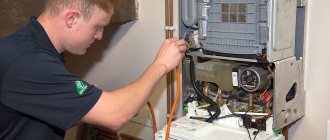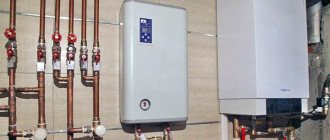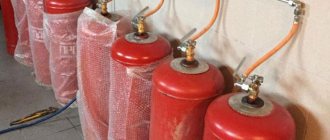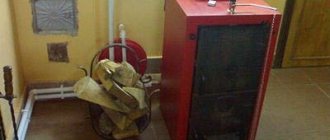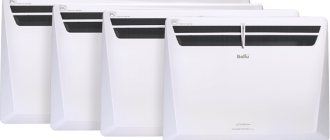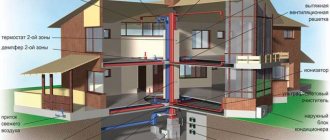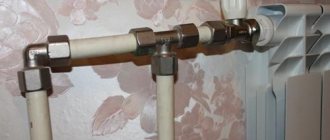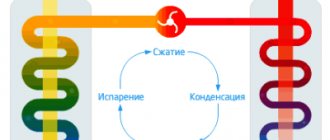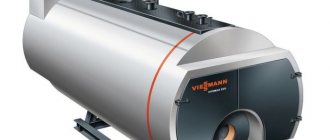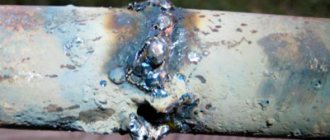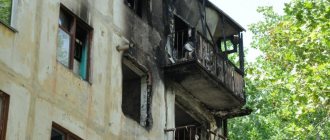Features of the operation of modern solid fuel boilers
Solid fuel boilers of the modern generation are equipped with a pressurization system and an automatic control unit. Electronics controls the temperature of the coolant using a sensor installed in the heat exchanger. Depending on the temperature conditions, the automation gives commands to turn on and off the blower, which supplies air to the combustion chamber and facilitates the effective removal of combustion products through the chimney. This regulates the intensity of the fuel combustion process depending on the temperature of the coolant.
Thus, the user takes the minimum necessary participation in the operation of the equipment. His concern about how to fire a TT boiler comes down to adding fuel at a certain frequency. After this, the boiler switches to intensive combustion mode. As the temperature rises, the combustion intensity weakens, and when the temperature reaches its maximum, the boiler goes into smoldering mode. After the coolant temperature drops below the set value, the boost is turned on again.
Timely loading of fuel into the TT boiler is the main task of the user, which cannot be automated. The number and frequency of fillings is determined based on the boiler power and the required temperature conditions. If you miss the start date, the boiler will only be able to operate in smoldering mode for a limited time, after which it stops.
It is of great importance how to heat a solid fuel boiler. Today the following types of fuel can be used for this purpose:
- firewood;
- coal;
- fuel briquettes;
- pellets.
To achieve maximum efficiency, you need to know how to effectively heat a solid fuel boiler with different types of fuel.
Operating principle of pyrolysis heating systems and efficiency
Construction of a pyrolysis boiler. (Click to enlarge)
Solid fuel itself burns slowly, and high temperatures are required for complete combustion of all flue gases. This is pyrolysis - a process in which the breakdown of organic substances occurs under the influence of high temperatures.
It differs from conventional combustion by limiting the access of oxygen to the fuel in order to avoid loss of primary combustion energy. The work of pyrolysis boilers and furnaces (gas generators) is based on this.
Structurally, the pyrolysis boiler has 2 gas-tight chambers connected by a nozzle. Fuel is placed in the first compartment (primary combustion chamber) and the boiler is ignited.
Another distinctive feature of the operation of gas generators is the boiler entering the closed mode. It starts after the fire has completely engulfed the fuel. Then, the access of free air is forcibly stopped and direct combustion is suspended. In fact, one part of the fuel burns, and the other part smolderes.
But the heat generated in this case is enough to form pyrolysis gas, which flows into the second compartment (combustion or afterburning chamber). Thanks to a certain portion of secondary air, the hot gas flares up, thermal energy is released and the boiler coolant heats up.
As for the pyrolysis furnace, it is a rectangular container with a built-in two-chamber sealed firebox. The combustion chamber is equipped with a supply and exhaust fan and a tight door. Fuel is loaded into it and set on fire. After the flame has set, the air supply is reduced by closing the firebox door.
The second compartment in stoves is often combined with an air duct or it is the base of the chimney. The movement of gases is ensured either by a fan (both the main supply and exhaust fan and a separate one), or by natural draft based on sealed dampers.
Typically, in pyrolysis stoves, firewood burns almost completely, leaving a minimal amount of ash (it can be removed once a week), but if necessary, incompletely burned remains of firewood can be removed. For this purpose, a rotary retort is used - the round part of the furnace container.
The principle of complete combustion in two stages and an increased firebox makes it possible to increase the efficiency of a pyrolysis boiler to 90-93%, and as for similar long-burning furnaces - up to 85%, compared to conventional ones.
Read a useful article about the features of the Geyser pyrolysis boiler here.
Which fuel to choose
When deciding what is the best way to heat a solid fuel boiler, it is necessary to take into account the recommendations of the equipment manufacturer. Certain boiler models can be designed for specific fuels. However, many modern units are capable of operating on all of the listed types of fuel.
When choosing how to heat a long-burning solid fuel boiler conveniently and profitably, you need to take into account the burn rate of the fuel, which can vary greatly for different types. The frequency of necessary bookmarks and the ease of use of the unit depend on this.
Dry firewood is the fuel that burns out the fastest. Therefore, today fuel briquettes, which are made from dry sawdust, are often used for TT boilers. Such briquettes, which are also called “Eurowood”, burn out 1.5-2 times slower than ordinary dry firewood. Peat fuel briquettes are also produced. However, they are characterized by high ash content, and therefore peat briquettes are used mainly for water-heating boilers with grate fireboxes. Coal burns the slowest. Some coal boilers, using high-quality anthracite and additionally equipped with a heat accumulator, are able to operate on one load for up to two days even in severe frost.
Pellets burn almost as long as coal, and at the same time provide a high level of efficiency. However, it is also the most expensive type of solid fuel for modern boilers. The main advantage of pellets is that they allow you to automate the operation of the boiler as much as possible, bringing it closer in convenience to the level of a gas unit. However, they cannot be used in a conventional TT boiler - it must be equipped with a special burner and a combustion door of a special design.
What to pay attention to
The operation of any heating device using coal, wood and other semi-finished fuel products is inextricably linked with the ventilation system. The performance characteristics of heating equipment and the technological parameters of the entire heating system in the house depend on the quality of ventilation and the condition of the chimney.
The hood must operate in accordance with established fire safety standards.
Important! An incorrectly made hood will create a risk of harmful combustion products entering living spaces. Insufficient traction will reduce the power of the device. Regular cleaning of the chimney will prevent soot from igniting, which can cause fire in house structures and create a fire hazard.
A properly made chimney and cleaning of the heating device will ensure long-term operation of the solid fuel boiler at optimal operating conditions. Frequently changing one type of fuel to another can cause unstable operation of the heating unit, failures in the hot water supply system and heat supply. Each unit should have one main fuel, while other types can be used for a short time, as needed.
Features of wood burning
To ensure high-quality heating, you need to know how to heat a solid fuel boiler with wood efficiently and economically. For kindling, chips are laid down, on top of which you need to place 3-5 firewood with a diameter of up to 15 cm. It is recommended to lay crumpled paper between the chips so that the wood flares up faster.
After the first fire has ignited, the firebox is filled with large firewood. To achieve the most complete and efficient burning of wood, you can place 1-2 large logs in the firebox at intervals of 30-40 minutes. In addition, this method will help reduce firewood consumption.
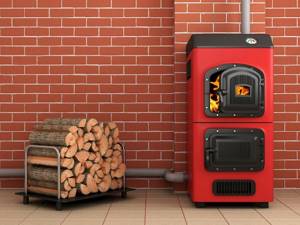
When the firebox is completely filled with large firewood, an ordinary modern solid fuel boiler is capable of maintaining fairly intense combustion for 3-4 hours. Long-burning boilers operate on one burner even longer. It is generally not recommended to burn such models with small wood, which does not burn completely due to increased gas emission. The optimal size of logs in diameter is 15-30 cm.
If you figure out how to properly heat a TT boiler, then the choice of firewood is of great importance. Wood moisture content should not be higher than 20%, otherwise the efficiency of the equipment will be lost. In some cases, to increase the burning time, damp wood is specially placed in the firebox, which takes longer to burn. However, it must be taken into account that this leads to increased release of tar, which settles on the walls of the firebox and on the chimney, and this causes deterioration in draft. As a result, the boiler has to be cleaned more often. In order for firewood to have an optimal level of humidity, it must be dried under a canopy for approximately 1.5-2 years before use.
If you want to increase the burning time of one bookmark, then you should not use damp firewood, but set the correct position of the gate valve and thermostat. These provisions for each TT boiler model are determined experimentally.
Main disadvantages
Like any other equipment, they have their disadvantages. The production process uses quite complex automation, which can significantly increase the cost of the device. As a result, the price turns out to be 2 times higher compared to conventional designs that have the same power.
Among other things, due to the fact that the combustion process is automated, the owner of the equipment cannot interfere with the operation of the boiler while the coal is smoldering. This indicates that it is not possible to extend the combustion life in such a device. Sometimes this creates certain difficulties during operation.
Features of coal combustion
Let's look at how to properly heat a solid fuel boiler with coal. For kindling, wood chips approximately 5 cm thick are used, which must be laid out on paper. You need to put 3-4 logs with a diameter of 10-15 cm on top of the wood chips. After this, you need to set fire to the paper and close the firebox door, as well as cover the ash pan. In this case, the draft must be sufficient to ignite the firewood. If the boiler is equipped with a slide valve, then it is only slightly opened when lighting. If there is a thermostat, then it should be set to a temperature of 70-80 °C.
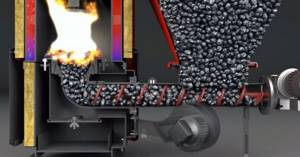
Coal can be added after 15-20 minutes of intense burning of the logs, when the chimney and the boiler itself are already sufficiently warm. In this case, you need to reduce the temperature set on the thermostat and fully open the gate valve. Before throwing coal, be sure to close the ash pit. The first layer of coal is laid with a thickness of 5-6 cm. After it burns out, a second layer with a thickness of about 15-20 cm is laid. Further layings also have this thickness.
It is also important what kind of coal to heat a solid fuel boiler. When using fine-grained fuel (up to 5 cm), it should be moistened by adding about a liter of water to a bucket of coal. The optimal fuel is large anthracite of a fraction of 6 cm. It does not require wetting. Water is added only if it is necessary to prevent overheating of the boiler.
How to avoid problems during construction and operation
The equipment is installed only on a concrete base. Rolled steel does not support the weight and the boiler sags. This leads to loss of joint tightness and damage to pipes.
It is not recommended to use a homemade door for the firebox and ash pan. The slightest irregularities reduce the efficiency of wood burning.
In addition, coals may fall out through the cracks with subsequent fire. When making a door yourself, it is made strictly for the hole, provided with flaps and thermal insulation between the layers.
If a boiler with a heat exchanger is used in a local heating network, the circulation pump is installed on the return line. This way the device operates in a gentle mode for 6 or more years. To solve the problem of low-temperature corrosion, a three-way thermostatic valve is installed on the bypass (jumper) and adjusted to 55 degrees.
A persistent smell of creosote and smoke in the boiler room indicate low quality fuel. Cheap wooden sleepers are not suitable for heating and form ash and coal residues on the walls in less than a day of combustion. To eliminate heat loss through the chimney, the latter is equipped with a damper. It prevents the escape of heated air and reduces the rate of fuel combustion.
Features of briquette firing
Now let’s take a closer look at how to properly heat a solid fuel boiler with briquettes. Kindling is performed using the same method as when using coal. It is important to consider what kind of briquettes you burn with. When using “Euro firewood”, kindling is done with wood chips and special small briquettes for ignition. If they are missing, then you can simply grind ordinary briquettes. If peat briquettes are used, kindling is done with wood chips and small firewood.
The first placement of briquettes is carried out after the formation of a stable flame and sufficient heating of the boiler. Wood briquettes (“Euro firewood”) are first laid in a layer of 10-15 cm. When it flares up well enough, a layer of briquettes 15-20 cm thick is laid. The first layer of peat briquettes should be smaller - about 5-6 cm. In the future, they are also laid in thickness 15-20 cm. The blower must be closed with each new addition of fuel. It is opened only after loading of briquettes has been completed and the combustion door has been locked. In this case, you need to install the blower in the correct position to create optimal traction.

During the combustion process, it may be necessary to stir the briquettes in the firebox. You should not do this too often, so as not to cool the firebox. Mixing must be done carefully, avoiding sudden movements, to prevent briquette dust from rising into the air and entering the room.
It is important to decide which briquettes are best to heat a solid fuel boiler. “Eurofirewood” is made from plant materials. The basis of these briquettes is dry sawdust. They may also contain husks of cereals and seeds. This type of fuel differs little in its properties from ordinary firewood, but it provides higher efficiency and burns out more slowly. During combustion, a large amount of soot is not formed. These features make wood briquettes the best option for heating a home or bathhouse.
When burning, peat briquettes emit a lot of ash, which leads to rapid contamination of the grate and ash pan, and also pollutes the room in which the boiler is installed. Therefore, this type of solid fuel is not recommended for use for heating residential buildings. The advantage of fuel briquettes is their lower price. In addition, they burn out more slowly than wood ones.
Tips for more efficient heating
If before refueling the boiler has recently been operating, and the chimney has excellent draft and has not yet lost its high temperature, it is enough to close the doors and, after turning on the control, record the desired temperature. After some time, you can remove the control unit and check whether the previously added part of the coal has ignited. If so, then it’s time to add additional combustion material. In this case, there is no need to close the slots in the front part of the grille.

Rice. 2 Automatic coal boiler
If the chimney is not preheated, after setting the paper on fire, the lower door of the ash pan must be opened
Next, without turning on the fan, it is important to give the device some time to warm up using natural draft. After the combustion intensifies, its thrust will increase significantly, noticing this, you can close the door tightly and activate the control unit by turning it on
When the chimney has not been used for a very long time, or it is new, it is worth warming it up well before lighting it. To do this, it is enough to set fire to the paper while inspecting the chimney until the draft in the boiler increases.
